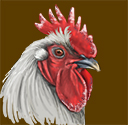
Frostbite occurs when fluid freezes in the cells of a chicken’s comb, wattles, or toes, depriving the tissues of oxygen. After a short period of having been frozen, the affected part may recover. If the part does not soon thaw, the cells may die and perhaps become infected. Further, a bloody comb or wattles resulting from frostbite may attract pecking by other chickens. So it pays to recognize the signs of frostbite and initiate timely treatment.
One of the first signs of frostbite is the appearance of pale, gray, or white tips on the comb or around the edges of wattles. Frostbitten feet and toes will appear unusually reddened. Subsequently, the frostbitten comb, wattles, or toes will swell, and within a day or so may begin to blister. Severe frostbite results in blackening of comb tips, edges of the wattles, or patches on feet. The affected chicken may lose interest in eating and other normal activities, indicating the bird is in pain.
If you discover the condition while the part is still frozen, slowly warm the frozen area. Do not use a heat lamp, heating pad, or other form of direct heat that warms rapidly, which would increase the pain. And do not rub the affected area, which would increase the damage.
To thaw a frozen foot, place the foot in warm water (100°F) for 20 minutes. To thaw a frozen comb or wattle, gently apply a damp, warm cloth to the frozen part for 15 minutes, rewarming the cloth as needed.
After the part has thawed, apply a hydrogel (water based) wound treatment. A spray such as Vetericyn is easy to apply without putting pressure on the affected part. Isolate the bird in a clean, warm facility, and keep an eye on it to see that the wounds heal properly. Use a feeder and waterer that won’t rub against the affected part. If the feet are involved, provide soft bedding and, if necessary, protect the toes with vet wrap or a protective shoe such as Birdy Bootie.
Frostbite is more likely to be discovered after the part has thawed and become swollen and painful. The bird appears listless and loses appetite. Since the part has already thawed, warming it is no longer necessary. Coat the part with a hydrogel spray, and isolate the bird so the damaged area has a chance to heal without getting pecked by flock mates.
After the swelling goes down, the skin may peel, the part may itch, and it may be sensitive to cold for a while. It may turn scabby, develop blisters, turn black as the tissue dies (dry gangrene), and eventually slough off — resulting in permanent disfigurement. Don’t be tempted to pop blisters or remove blackened tissue, both of which aid healing.
Infection (wet gangrene) can be a serious and even life-threatening complication of frostbite. A sign of infection is bad-smelling fluid leaking from a wound that isn’t healing. To prevent the spread of infection, the affected part may have to be surgically removed, requiring the attention of a veterinarian or other person who is experienced in performing the procedure.
Frostbite is a painful experience that can result in a disfigured comb and wattles and the disabling loss of toes. Frostbite in a rooster can mean reduced fertility, and in a hen can reduce egg laying. Rather than wait until frostbite occurs, the better plan is to take proactive measures to protect your chickens from frostbite.
And that’s today’s news from the Cackle Coop.
Gail Damerow, author, The Chicken Health Handbook
<! — Blog –>


This has been very helpful… thank you
[…] the down side, such large combs are more susceptible to frostbite. In cold climates, breeds with tight combs cope better with the cold than breeds with large combs. […]